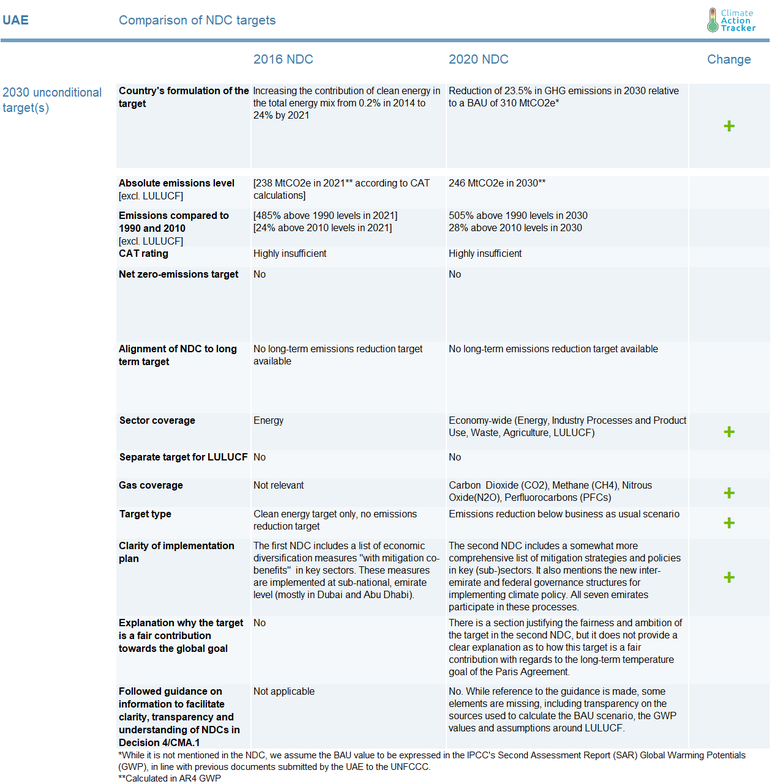Summary
The United Arab Emirates submitted its updated NDC in December 2020. The update includes the UAE’s first emissions reduction target for 2030, which the CAT still rates as Highly Insufficient, the same rating as the first NDC target, which was a clean energy target for 2021. The updated NDC aims for a decrease in emissions of 23.5% below business as usual (BAU) in 2030. This would translate to an emissions level of 246 MtCO2e, excluding LULUCF.
CAT analysis of NDC update


The UAE submits an updated NDC with first economy-wide emissions reduction target for 2030
In its first NDC, the United Arab Emirates did not have an emissions reduction target, only a clean energy target for 2021. As such, the 2030 emissions reduction target in the second NDC represents clear progress compared to the previous one. However, our rating of the UAE’s climate pledge does not change—we still rate it “Highly Insufficient”.
The new target is expressed as a 23.5% reduction below the BAU scenario in 2030. The BAU uses the year 2016 as a reference point and does not take into consideration the impacts of the COVID-19 pandemic on economic growth. However, the NDC mentions that the speed of economic recovery will feed into the “UAE’s ongoing review of its climate and energy goals”.
We calculate the new target to be 246 MtCO2e, excluding LULUCF, which falls within the CAT’s emissions estimate for current policies, taking into consideration the effects of the pandemic (239–278 MtCO2e). The UAE could strengthen its target by reflecting recent policy developments beyond 2016 and the impacts of the COVID-19 pandemic in its BAU scenario.
The UAE does not have a net-zero target, nor has it submitted a long-term strategy to the UNFCCC. The UAE has issued a 2017–2050 National Climate Plan, but it does not include an emissions reduction target, nor does it refer to long-term mitigation actions beyond the electricity sector.
The NDC target has not yet been translated into domestic legislation. However, it mentions some of the policies and strategies that underpin the 2030 target. This includes the UAE’s National Energy Strategy 2050, which aims for 50% of renewable and nuclear energy in installed electric capacity by 2050, while substantially reducing final electricity demand. This strategy also plans for 12% of coal and 38% of natural gas-based capacity, which is inconsistent with the need to reach net-zero CO2 emissions globally by 2050.
Other policies mentioned include the development of the rail and public transportation networks, emissions performance standards for cars, various energy efficiency measures and better waste management practices.
Assumptions
LULUCF
The target in the second NDC includes LULUCF emissions. To estimate the emissions level resulting from target excluding LULUCF, we assumed constant LULUCF emissions between the latest data point available (2014) and the NDC target year (2030).
Global Warming Potential (GWP) values
The GWP values used are not specified in the second NDC. We have assumed that GWPs from the IPCC’s Second Assessment Report (SAR) are used, in line with previous documents submitted to the UNFCCC. We have converted the 2030 BAU value from SAR to AR4 using a conversion factor for the last available data point (2014).
Links
Stay informed
Subscribe to our newsletter
